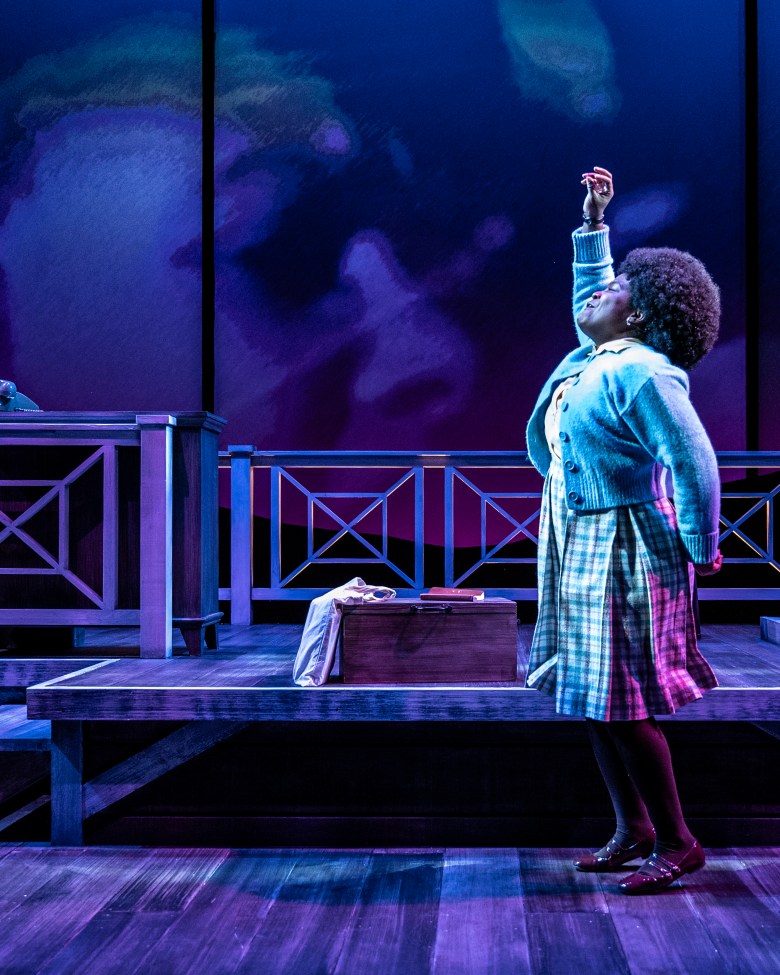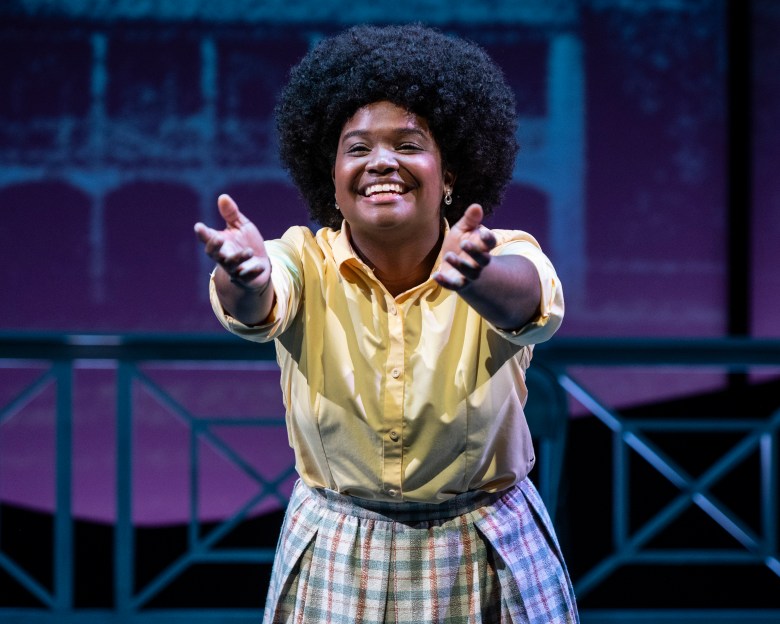At Everyman Theatre, a hazy purple and tangerine sunset lights the stage as the three-pane backdrop conjures the image of a mountainous Vermont skyline. Under the supervision of dedicated ushers, the crowd settles in for the opening night of “Queens Girl: Black in the Green Mountains.” The play is the final show in a trilogy of solo performances from playwright Caleen Sinnette Jennings. This final entry, performed in front of a live audience for the first time this month, chronicles the journey of Jacqueline Marie Butler at Bennington College from 1968-1972.
In this run, Deidre Staples stars under the thoughtful direction of Danielle A. Drakes. As a solo performance, the play focuses the audience’s eyes on the comedy and conflict of building a self-identity in a world full of wars and political violence.
In this run, Deidre Staples stars under the thoughtful direction of Danielle A. Drakes. As a solo performance, the play focuses the audience’s eyes on the comedy and conflict of building a self-identity in a world full of wars and political violence.
Jennings’ playwriting offers a solo performance made up of many different voices. The result is a collage of characters with dynamic personalities where no interaction or chronological detail is taken for granted. Each conversation, whether aloud or within the confines of Butler’s inner monologue, is evidence of the strife that comes with building a self in a world dominated by U.S. imperialism. Throughout the production, the play’s historical frame features discussions of the Biafran War in Nigeria, Malcolm X’s assassination, the Vietnam War, and the May 4 assassination of four Kent State students at the Democratic National Convention in 1970. And the inspiration for this is the real life of the work’s playwright.

“Queens Girl: Black in the Green Mountains” is a piece of autobiographical fiction derived from parts of Jennings’ life and events of the late 1960s and early 70s. In her own life, Jennings earned her bachelor’s degree in drama from Bennington College in 1972 before receiving her MFA in acting from the Tisch School of the Arts at New York University. Furthermore, before the play begins, Vincent Lancisi — founder and artistic director of Everyman — reminds audiences that Everyman Theatre’s connection to this final play is strong. “Queens Girl: Black Girl in the Green Mountain” was originally commissioned and produced here.
Under Drakes’ direction, Staples embodies over ten distinct characters. In the show’s 72 minutes, she enters the skin of college administrators, eccentric professors, and many more to deliver a story about Butler’s young adulthood. The Memphis native is a comedic triumph throughout the show. Her sense of timing and mastery of proxemics, meaning the distance she places between herself and another iteration of herself, is a joy to watch. Drakes and Staples credit using rasa aesthetics, an Indian artistic concept that encourages artists to consider the essence of a work, as a key component in their practice of building each character and moment in the production.
While Butler is the dramatic nucleus of the performance, the play is a comedic volley filled with the voices of parents, peers, and elders who shape Butler’s worldview. As a piece of a larger three-part vision, “Black Girl in the Green Mountains” is just one entry in Jennings’ coming-of-age trio. This fact means that each edition in the trilogy is tasked with spanning years at a time with little room to settle into one moment and stay.
As the production progresses, audiences will come to know many different voices. The interpersonal conflicts between characters catalyze discussions of integration, sexuality, and geopolitics.
As the production progresses, audiences will come to know many different voices. The interpersonal conflicts between characters catalyze discussions of integration, sexuality, and geopolitics. One moment we’re learning that Butler’s lover is in exile from Apartheid South Africa and the next we’re watching Butler grapple with virginity and women’s sexuality workshops.
My favorite character of the night was Staples’ characterization of Aunt Maisie, a scotch-drinking, chosen elder who isn’t scared to cuss up a storm. While Butler’s parents are away in Nigeria treating victims of war wounds, Aunt Maisie serves as her “mother on this side of the Atlantic.” The character is a nod to the found families that Black people across the diaspora create with each other to keep children safe and cared for when labor may take caregivers far from home. This performance requires Staples to execute varied dialogue, tone, and delivery. And in each regard, Staples is a skilled lead. No line feels lost or redundant in the sea of conversations (a commendable feat when characters cross cultures and ages within seconds).
As a solo performer, Staples commands the stage with the help of other artists on the Everyman roster. With the support of a crew of talented dramaturgs, set designers, and other creatives, Staples brings us into the world of Bennington and 1960s life. The work of set designer Daniel Ettinger and lighting designer Harold F. Burgess II, both resident company members at Everyman, deepens the performance before any lines are spoken. The design work is incredible as the space transforms from a small stage in a black box theater into collegiate dorm rooms, Vermont mountainsides, and New York City streets. The details of spotlight hues, bookshelf placement, and visual projections ground the play without distracting from Staples’ character work. The balance struck between the visuals is harmonious.

In addition to the visual offerings of the design crew, Staples’ performance is accompanied by incredible sound design. Sarah O’Halloran’s work shines throughout the performance. O’Halloran’s use of musical refrains, like the recurring instrumental refrain from Moon River when Butler mentions her lover, Gilliam, complements Staples’ acting and Drakes’ direction wonderfully. Moreover, with the number of references to musical talents like Sly and the Family Stone, Aretha Franklin, Sonny Rollins, and others throughout the play, music is a key textual element layered into the production. The inclusion of John Coltrane’s instruments and Otis Redding’s soulful vocals in “I’ll Be Loving You” (1965) further immerse audiences in the world Jennings builds.
With the trilogy format in mind, this production left me yearning for more insight into Butler’s political commitments. From various conversations throughout the play, we learn that she struggles with her role in political organizing and art as the daughter of a middle-class Black family and yet, we get little insight into what she truly thinks of the wars, protests, and art around her. By the play’s end, I wondered: “What does Butler think about the U.S.’s war in Vietnam? Does Butler dive into political ideology? Where does she align herself in political struggle?” In the wake of the show, I’m still wondering about her journey as an artist amid the Black Arts Movement of the 60s and 70s.
Despite my hope for more time with Butler’s political ideology, I commend Jennings for crafting work linking political struggles in and outside the United States. Through Butler and her loved ones, we watch a play about how life in New York City connects to the Biafran War and the anti-war protests of the 20th century. This production is one reminder that the contemporary anti-war organizing being done in the U.S., spurred by ongoing funding of genocides in Palestine, Sudan, and Haiti (among others), is a continuation of a long legacy.
Despite my hope for more time with Butler’s political ideology, I commend Jennings for crafting work linking political struggles in and outside the United States. Through Butler and her loved ones, we watch a play about how life in New York City connects to the Biafran War and the anti-war protests of the 20th century.
The collective efforts of the playwright, cast, crew, and director skillfully fill out this production. After this performance, I am curious about the other two plays in the trilogy and their thematic journeys. At the reception following the show, I spoke briefly with Drakes about the challenges and triumphs of solo performances. With this production, Drakes has been a part of 10 solo shows in her career (serving as both actor and director across her experience).
“I’m glad this show is impactful,” she told me. “There’s heavy themes throughout and it takes work to convey that to an audience.”
Queens Girl: Black Girl in the Green Mountains is showing at Everyman Theatre through November 17.
